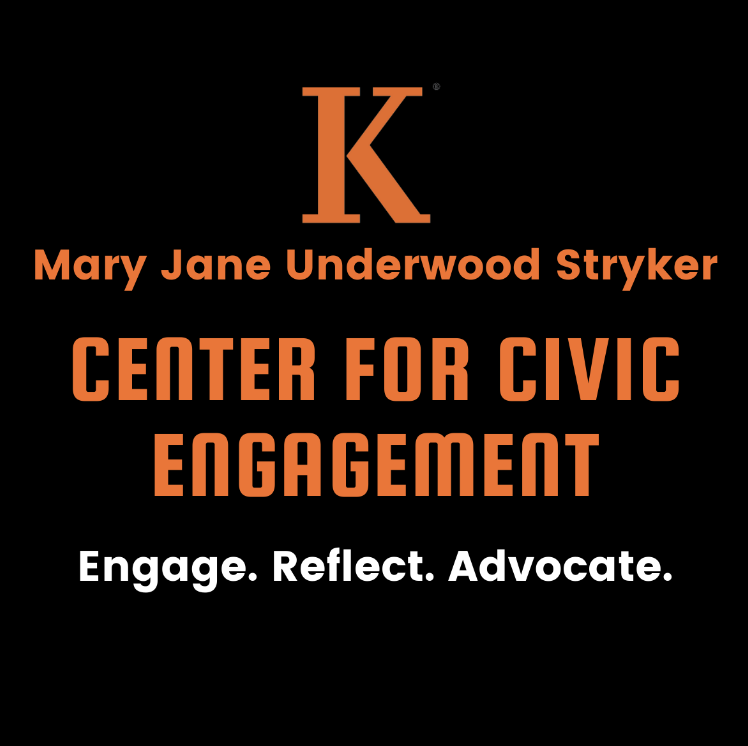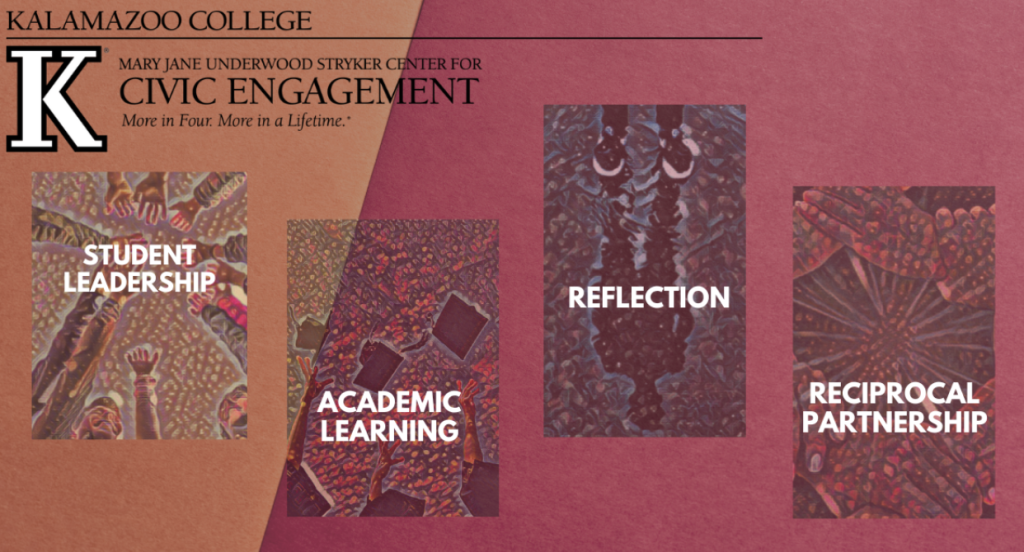
On a rainy Tuesday evening, Olivia Laser ’26 steered her car into the parking lot of the YWCA of Kalamazoo at the same time as Joseph Stein ’25. The YWCA of Kalamazoo works to support survivors of violence, which often includes offering transitional housing to those in need. Olivia and Joesph volunteer at the shelter in a childcare program to give parental figures staying there breathing room. The students walked to the door together and pressed the buzzer to be admitted into the building. “We’re here to volunteer,” they said in chorus when the buzzer was answered.
After being let into the building, they made their way to the gym. Tables with books were pushed up against the far wall, with unused furniture pushed up against another. Scattered around the gym were donated toys of all kinds. Inflatable balls, jump ropes, and plastic toy cars littered the floor under the fluorescent lights. Alone in the gym for the moment, Joseph and Olivia kicked around a kickball and were soon joined by their coworker, Chloe Bryant ’26.
Before long, the elevator down the hall dinged. Soon, the gym doors burst open to let in the 10 kids, aged 1 to 9, that were attending the day’s session.
Volunteer service is a requirement for Dr. Karyn Boatwright’s Feminist Psychology of Women course; however, the type of civic engagement is entirely up to the student and there are a multitude of options. Beyond the YWCA, students can volunteer with Woodward and Lincoln Elementary, Planned Parenthood and more.
Dr. Boatwright frequently involves her students in civic engagement through her psychology classes, and described its valuable learning-outcomes. It’s “putting students into the world where they can encounter true issues of injustice and inequity and oppression and not as bystanders, not as cultural tourists, but as people who are getting in there and working with the people towards solutions,” she said.
This sentiment is echoed by Alexandra VanHeest, interim director of the Center for Civic Engagement (CCE), an organization on campus that engages in community outreach. “We believe our students can learn and supplement their classroom learning in really powerful ways by doing work in the community,” she said.
As soon as she saw Olivia enter the gym, a 4-year-old’s face lit up. Having been volunteering twice a week for a month now, Olivia was a familiar and friendly face to many of the kids. Throwing her arms up in excitement, the 4-year-old girl seized Oliva’s hand and guided her over to a table with books on it, expressing her desire to read with Olivia.
Books can only hold a 4-year-old’s attention so long, and Olivia was imminently pulled to one of the plastic cars laying around the gym. The 4-year-old climbed into a red and yellow plastic cart and motioned for Olivia to push her around, which Olivia did happily.
Mirroring them on the other side of the gym, Chloe pushed another girl around in a similar cart. Seeing each other across the gym, Chloe and Olivia led each other on chases across the gym, with their respective cart occupants cheering them on.
Civic engagement is beneficial on both ends, giving students experience and offering community programs much-needed help. “It’s reciprocal, they’re learning but they’re also bringing value,” VanHeest said. The reciprocal nature of the civic engagement programs at K is the reason professors reach out to include some kind of civic engagement in classes. While some professors have consistently worked with the CCE for years, such as Professor Cyndy Garcia-Weyandt and Professor Candance Combs, the CCE works with new professors frequently.
“We have faculty all the time who are exploring new ideas,” VanHeest said. “We have an economics professor who I’m in communication with about what a community engaged course with the city could look like for the spring. There’s a scientist professor who’s working on a community engaged course for the spring in partnership with the Children’s Nature Playscape downtown.”
Having gotten tired from being pushed around in a cart, the 4-year-old girl and Olivia made their way through the perilous center of the gym where Joseph was throwing dodgeballs around with a few kids to stop at the water fountain Joined on the way by a 4-year-old boy, the two of them took turns filling up red solo cups they brought from upstairs.
Deciding water was boring, the 4-year-old boy proclaimed the water in their cups to be Sprite. Delighted, the 4-year-old girl agreed, and they happily sipped their “Sprite” before they dumped the cups back into the fountain. Unfortunately caught in the splash zone, Olivia was mildly damp as she escorted them back into the gym for cleanup.
The partnership between the CCE and professors on campus is crucial to making civic engagement opportunities a success. “They are our hub. I wouldn’t be able to do it without them,” said Dr. Boatwright. Just as professors work with the CCE to give students and the community these opportunities, the CCE works with over forty community leaders to build and maintain relationships.
“A big part of my role is building and maintaining partnerships in the community,” said VanHeest. By consistently reaching out to programs in the community, the CCE can continue to connect students and community leaders. This outreach is crucial to, as Dr. Boatwright said, “building a bridge between our school, our students and our community partners.”
The CCE is crucial in providing funds to civic engagement programs within classes, with established programs having a budget provided by the CCE for any costs. Unfortunately, newer programs frequently have a more difficult time advocating for funds. Specifically, this year the Woodward Elementary program needed culturally sensitive empowerment books.
With the CCE finding tied up in other programs, Dr. Boatwright stepped up to raise the money for books for her students volunteering at Woodward, speaking to the dedication of professors who go to the lengths to include civic engagement in their courses.
“I put out a call to Facebook and to friends and showed them the eight hundred dollars of books we needed, and then the people of Facebook chipped in, and we raised eight hundred and twenty-five dollars for books,” Dr. Boatwright said.
Having placed the toys in a haphazard pile in the corner of the gym, Olivia, Joseph, and Chloe waved goodbye as the kids reluctantly made their way back upstairs to their families. The protests of the kids over the dismissal of the volunteers were subdued with the promise that they would be back soon.


Leave a Reply